2024, ഡിസംബർ 18, ബുധനാഴ്ച
മലങ്കര സഭാ കേസ് സുപ്രീംകോടതി ഇടക്കാല ഉത്തരവ് മനോരമ റിപ്പോർട്ട്
2024, ഡിസംബർ 1, ഞായറാഴ്ച
Is it true that the biblical Adam and Eve existed?

Is it true that the biblical Adam and Eve existed?
September 15, 2015
- Related Topics:
- Genetic myths,
- Ancient DNA,
- Chromosomes,
- Evolution,
- Human evolution,
- Genetic genealogy,
- Mutation,
- Population genetics
A curious adult from California asks:
“I have seen a lot of articles lately saying that genetics proves the existence of the Biblical Adam and Eve. Is this true?”
No, it is not true. Scientists can trace our maternal and paternal lines back to a woman and man who lived a long time ago, but they are not the Biblical Adam and Eve. People refer to these two individuals as “mtEve” and “Y-Adam,” for reasons we’ll explain below.
Fossil evidence shows us that these two individuals were part of a whole population of our ancestors-- they were definitely not alone on Earth. And instead of living 6000 years ago as some would have us believe, our DNA suggests that these two lived more than 100,000 years ago.
Given this information, there is no reason to believe they ever met, or even lived in the same region of Earth. In fact, they exist only because of simple statistics.
But how can we know how long ago these two lived? After all, no one alive today was around to tell us their story.
We can figure it out by comparing lots of different people’s DNA. Because our DNA changes as it is passed from parent to child at a pretty constant rate, we can figure out how long ago everyone had the same starting DNA. These changes mark the age of a piece of DNA like ticks on a clock.
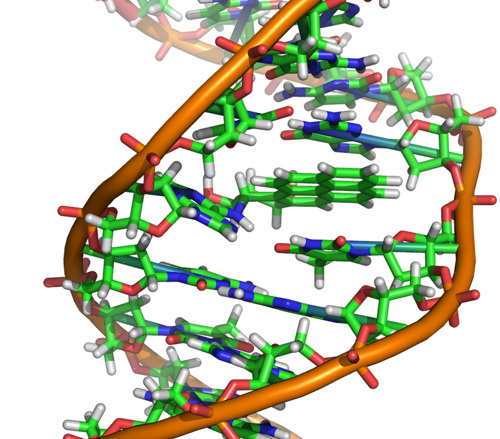
Mutations and the Age of DNA
You might be surprised that DNA can change over time. But it does. It is where all the wonderful diversity of the natural world comes from.
For the most part, the forces that change our DNA, like UV light from the sun, and the cell’s mistakes when copying DNA, don’t change very much. Unless something like Chernobyl happens, mutations happen at a pretty constant rate generation after generation.
What this means is we can count the changes in a piece of DNA to figure out how old it is. If we get 10 new changes (or mutations) in a generation, and there have been 100 mutations, then it has been ten generations. This is basically the idea behind the “molecular clock.”
Because of how our DNA works, we can’t trace just any DNA back thousands of years. We can really only use the Y-chromosome to find “Y-Adam” and mitochondrial DNA (mtDNA) to find mtEve.
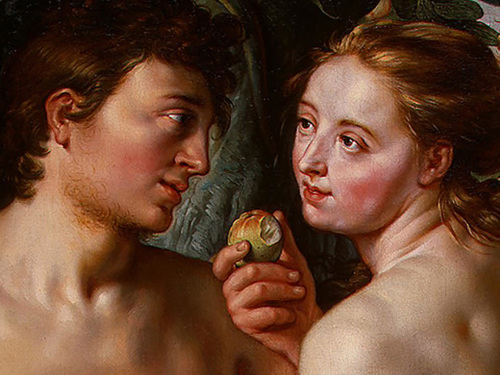
When we look at this DNA, we can see that Y-Adam and mtEve were almost certainly not the Biblical couple. If these two really lived together 6000 years ago, then scientists would have miscalculated the mutation rate really badly.
To get these two on Earth as recently as 6000 years ago, we’d need a mutation rate 40 times higher than the one scientists have actually calculated.
There is no reason to think that there was such a high rate of mutation at any point in the last few thousand years. In fact, a different group of researchers used family trees to look back 800 years and they saw the same mutation rate predicted by the scientists.
How Scientists Did it
Of course, backtracking DNA 100,000 years isn’t that easy. Let’s focus on finding Y-Adam’s age first, but the same principles apply to mtEve.
Scientists had huge problems facing them when searching for Y-Adam’s age.
First, we don’t have Y-Adam’s DNA to compare. We had to figure out what his chromosome looked like based on the DNA of many men alive today.
To solve this, researchers used powerful computer programs that compare the Y-chromosomes of men living today to put together Y-Adam’s chromosome. Of course, they couldn’t look at the Y chromosome of every man on the planet.
Instead, they used a group of about 70 men from many different areas of the world to try to represent as many people living today as possible. The computer takes these DNAs and puts them in order of ancestry based on their similarities and differences. The result is a tree (called a phylogenetic tree), that shows which Y chromosomes are mutated versions of others.
In other words, it shows the order in which each version of the Y chromosomes appeared. This tree looks roughly like this:
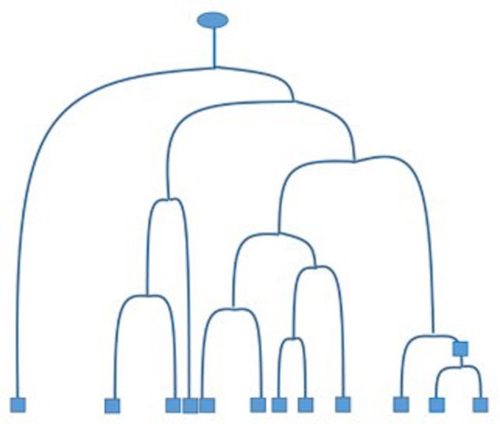
Each branching is a new change added to the chromosome being passed on from father to son. The squares at the bottom represent men living today from different areas of the world and the circle at the top is their most recent common ancestor, or Y-Adam.
We only know the sequences of the Y’s from men alive right now, but the computer can guess or extrapolate the sequences in between them and Y-Adam. It also gives us a pretty good guess as to the sequence of Y-Adam’s own chromosome.
This is only the first step though. We now have to figure out how long it took to get from Y-Adam’s DNA to the DNA we see today. For this we need to know how many new changes a Y chromosome gets per generation. Once we have the mutation rate, we can calculate the years it took to get from Y-Adam’s sequence to those we see today.
Using a variety of methods (click here and here for two examples), scientists have calculated the mutation rate of the Y-chromosome and of mtDNA. They then used the sequences they reconstructed for Y-Adam and mtEve to figure out how many changes there have been since then.
Next, they divide the number of changes they found by the mutation rate (in number of changes per generation) to get the number of generations.
In order for the ages of Y-Adam and mtEve to be as young as 6000 years, the generation time would have to be less than one year – which we know is impossible. (This would mean parents have a child, which then gives birth to its own child within one year, and so on).
So the only possible way that they could have lived 6000 years ago is if the mutation rate was wildly off. And we have direct evidence that if the rate is off, it is not off by nearly enough to make Adam and Eve 6000 years young!
More Direct Evidence
Added to the sequencing of distant relatives, we also have some direct evidence for the mutation rate of the Y-chromosome.
There is a lot of evidence to support the idea that all the original inhabitants of North and South America got there from Siberia. Using a really cool technique called carbon dating, scientists have figured out that this happened about 15,000 years ago.1
So we have a pretty good idea when people got to South America. But it seems like we still don’t have anything to compare native populations to. Or do we?
It turns out that soon after coming to the Americas, one man got a mutation in his Y chromosome. This man was pretty successful, so this Y has become very common there. But not everyone has that Y chromosome.
Here is an image that helps to explain how this worked:
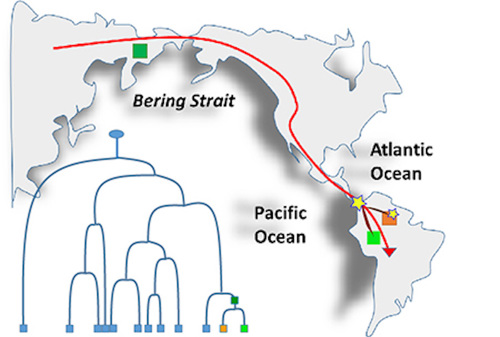
The orange and electric green Y chromosomes at the bottom of the tree are from two men living in different populations of native South American. The orange man has the "M3" mutation in his Y chromosome – let’s call it the star mutation for ease – and the electric green man does not.
It turns out that lots of people living today in South America have the star mutation, and it’s not found anywhere else in the world. So it must have happened right when people were first moving into the continent.
We also know that both the orange and electric green Y chromosomes are passed down from the ancestral dark green Y chromosome above them in the tree. This Y has some mutations that are only found in people living in Siberia.
These clues led scientists to understand that the green Y chromosome was from a population in Siberia that migrated over the land bridge to settle all over South America. Right around the time they arrived there, the star mutation appeared in some of the population – but not all.
So the men we see today with the star mutation (the orange Y) are descendants of the dark green men who first got it. Not all the men in the dark green population, of course, got the mutation – it started out with just one man and then was passed on to his sons and their sons. So originally, some men in the dark green population passed on Y chromosomes without the star mutation – their descendants are men like the electric green Y, with Y chromosomes missing the star mutation.
All this told scientists that the orange and electric green Ys are 15000 years apart from their ancestral dark green Y chromosome, from which they both originate – one with the star mutation, and one without.
Now that they have a time, they just need to sequence the dark green and the orange Y chromosome and see how many mutations happened over that 15,000 years. From this they got a mutation rate for the Y chromosome.
(Of course, they could also look at the number of differences between the dark green and the electric green – they should be very similar because the same 15000 years separate them in time. They did this as a mathematical check, and found a very similar mutation rate).
In fact, as we look at more and more men’s Y chromosomes, we could even push Y-Adam back in time. For example, recently, scientists found some living men’s Y chromosomes that are very rare and different, and cannot be traced back to the current Y-Adam. They had to put these men along with the ones we already looked at, and find the most recent common ancestor of all of them. This means changing the identity of Y- Adam, and pushing him farther back in human history. All the way to 338 thousand years ago!2 This is older than any other estimate and older than any fossils we’ve found from modern humans!
So, mtEve and Y-Adam are just clever nicknames based on a statistical truth. They were not the only female and male living during their time. They were just the ones whose DNA has survived to be passed on to living people.
And their identity is not certain. The more people we look at, the farther back in time Y-Adam and mtEve could get pushed.
The one thing we do know for sure, though, is that humans first came about much farther back in time than the stories of the Bible tell us.
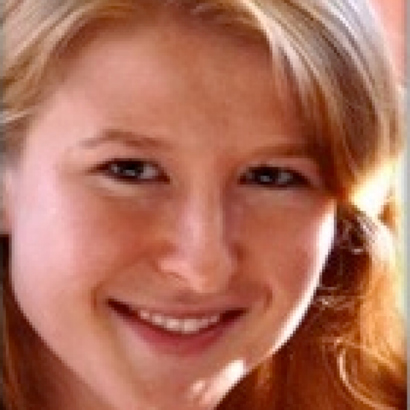
Author: Sandra Cristea
When this answer was published in 2015, Sandra was a Ph.D. candidate in the Cancer Biology program working in Julien Sage’s lab, where she studied how to leverage enzymes to better understand and treat small cell lung cancer. Sandra wrote this answer while participating in the Stanford at The Tech program.
2024, നവംബർ 7, വ്യാഴാഴ്ച
SupremeCourt Rejects Plea-of Christian Nuns Priests Sgainst TDD Application To Their Salaries
The Supreme Court today (November 7) dismissed a batch of 93 appeals challenging the application of the Tax Deduction at Source (TDS) on the salaries given to nuns and priests of the Catholic Church who are working as teachers in aided institutions.
The bench comprising Chief Justice of India DY Chandrachud, Justices JB Pardiwala and Manoj Misra was hearing the challenge to the judgment of Madras High Court which held that Tax Deduction at Source (TDS) must be applied with respect to the the salaries given to nuns and missionaries.
The Counsel for the petitioners explained that the nuns and priests have taken a vow of poverty and hence, the salaries earned by them by working as teachers in aided institutions are handed over to the diocese/convents. Therefore, the salaries are not accrued to them personally.
CJI then pointed out that the salaries are received by them in their personal accounts.
"Salary is received, but because of the vow of poverty, they say I will not retain the salary because in the diocese/parish, they cannot have personal income...But how does it affect the taxability of the salary? TDS has to be deducted."
The CJI further stressed the need to have a uniform application of law - that any person employed and receiving a salary would be subject to taxation.
"If there is a Hindu priest who says I will not retain this salary, and give the money for doing puja to an organisation. But if the person is employed, he gets the salary, tax has to be deducted. The law is common for everyone. How can you say that it is not subject to TDS?"
"When the organization pays a salary, and it is treated as salary in the books of accounts of the organization, but that is not retained by the person and paid somewhere else, the application of money, either to the diocese or someone else, has nothing to do with taxability," CJI said.
"This is salary in its true sense," Justice JB Pardiwala said. The Counsel said that they were protected by circulars issued from 1940s and the department initiated proceedings after someone wrote a letter to them in 2015.
The Counsel then submitted that the Kerala High Court in a few of its decisions has held that the family of a priest or nun, on his/her death cannot claim compensation under the Motor Vehicles Act. The CJI explained that the reason for this is that through their vows, the nuns and priests break the mortal bond with their family and become 'ascetics'. Therefore, the families cannot claim compensation on their behalf. However, taxation stands on a different footing, CJI Chandrachud explained.
Senior Advocate Arvind Datar, who then joined the proceedings virtually, submitted that the appellants would work in government-aided schools and receive the said salaries for teaching. However, by the end of the month, the salaries in their names would go to the Diocese and it would be the Diocese which pays the tax as a charitable trust instead and not the nuns/priests. He added that the priests/nuns do not file income tax returns.
"They have renounced the world... The priest gets nothing. They don't get provident funds. For the last 85 years, the priests were never taxed."
"If you are not liable for TDS, you can make a claim for a refund," CJI suggested. Datar then said they are not assessees.
"Without a statutory exemption, taxation cannot be avoided," CJI said. "As per the definition of the Income Tax Act, an individual is a person who is capable of receiving money. They are not. They are virtually people who suffered civil death. I am not capable of earning a taxable income," Datar said.
He further added that not every receipt is taxable, and for a receipt to be taxable, it should be in the form of an income, but presently, the nuns/priests were not retaining the salaries for their own use. Datar said that the circular of the CBDT saying that priests/nuns are exempted from TDS still holds the field. He said that over four thousand priests would be affected.
Seemingly disinclined to entertain the matter further, the bench dismissed the appeals.
"We will not entertain, thank you Mr.Datar," CJI said.
Madras High Court Judgment
The Division Bench of Madras was hearing the appeals filed by the Income Tax Department against the judgment of a single bench, which had allowed the writ petitions filed by catholic religious institutions challenging steps taken for recovering TDS amount on salaries paid to priests/nuns employed in aided educational institutions.
The single bench had accepted the case of religious institutions that since priests/nuns have taken a vow of poverty as per which they have to surrender their personal income to the Church/Diocese, no income is effectively accrued to them so as to make it liable for taxation. It further held that priests/nuns have suffered civil death as per Canon Law and renounced the world and therefore cannot be subjected to TDS.
The Division Bench of Justices Dr. Vineet Kothari and C V Karthikeyan set aside the judgment of single bench, holding that the salaries were received by them in their individual capacity and that the subsequent surrender of their salaries to the religious institutions can only be treated as an application of income. The Court further held that religious institutions cannot claim to have an overriding title with respect to the salaries at the source itself.
The Madras High Court relied on the judgment passed by the Kerala High Court in Fr Sabu P Thomas v Union of India, which explained the concept of 'diversion of income by overriding title' was not applicable in the case. This concept refers to a pre-existing legal obligation to divert the income to another. The person to whom the amount is diverted should have a legal right that entitles him to claim the amount directly from the source, and without the intervention of the person who would have received the amount but for the said legal arrangement. The diversion of income must be effective at the stage when the amount in question leaves the source.
The High Court noted that income accrued to the nuns/missionaries in their individual capacity, and was credited to their individual accounts. The organization had no claim over the salaries at the source itself, and they were not privy to the contract of employment with the nuns/missionaries..
"we find that the salary in question was not directly received by the Congregation or Religion by overriding diversion of title, but were paid by the State to the Teachers who are Nuns or Missionaries and thereafter, it might have been applied or made over to the Church or Diocese or the Institution run by them"
"The salary is paid under the contract of employment with which Educational Institution or the Church or Diocese is not even a privy to such contract of employment qua the State Government", observed the Court.
From a reading of Section 192 of the Income Tax Act, the Court held that the religious character of assessee does not impact the TDS liability.
Case : Institute of the Fransican Missionaries of Mary and others v. Union of India SLP(C) No. 10456/2019 and connected cases.
https://www.livelaw.in/top-stories/supreme-court-rejects-plea-of-christian-nuns-priests-against-tds-application-to-their-salaries-274555
2024, നവംബർ 6, ബുധനാഴ്ച
വയലിപ്പറമ്പിൽ ഗീവറുഗീസ് ഗ്രീഗോറിയോസാ
മോർ മീഖായേൽ റാബോ
2024, ഒക്ടോബർ 26, ശനിയാഴ്ച
Pope Francis: Keep your homilies short or ‘people will fall asleep
Pope Francis: Keep your homilies short or ‘people will fall asleep’
Rome Newsroom, Jun 12, 2024 / 09:35 am
Pope Francis has once again appealed to Catholic priests to keep their homilies short, this time warning that homilies should be no longer than eight minutes or “people will fall asleep.”
Speaking in St. Peter’s Square for his Wednesday catechesis on June 12, the pope explained that the goal of a homily is to “help move the Word of God from the book to life.”
“But the homily for this must be short: an image, a thought, a feeling. The homily should not go beyond eight minutes because after that time you lose attention and people fall asleep,” he said.
It is not the first time that Francis has stressed the importance of short homilies. In 2018, the pope urged priests to “be brief” and ensure that their homilies are “no more than 10 minutes.”
The pope’s words echo the recommendations made by Archbishop Nikola Eterovic in his 2010 book on the 2008 Synod on the Word of God, which advised prelates to keep their homilies to eight minutes or shorter and to avoid “improvisations” from the pulpit.
Pope Francis often exceeds this time limit in his own homilies. On Holy Thursday this year, the pope’s homily for the chrism Mass was more than 20 minutes long.
The pope made the comments on homily length off the cuff during a reflection on how the Bible is “inspired by God and authoritative.”
Francis added that “the Holy Spirit, who inspired the Scriptures … also makes them perennially living and active.”
It can happen that in a certain passage of the Scripture, that we have read many times without particular emotion, one day we read it in an atmosphere of faith and prayer, and then that text is unexpectedly illuminated, it speaks to us, it sheds light on a problem we are living, it makes God’s will for us clear in a certain situation,” the pope said.
“The words of the Scripture, under the action of the Spirit, become luminous; and in those cases, we touch with our own hands how true is the statement in the Letter to the Hebrews: ‘The word of God is living and active, sharper than any two-edged sword’ (Heb 4:12).”
Pope Francis urged Catholics to take time every day to read and reflect on a passage from Scripture, recommending that Christians carry “a pocket Gospel” with them to read during spare moments throughout the day.
“But the quintessential spiritual reading of the Scripture is the community reading in the liturgy in the Mass,” he said. “There, we see how an event or a teaching, given by the Old Testament, finds its full expression in the Gospel of Christ.”
“Among the many words of God that we listen to every day in Mass or in the Liturgy of the Hours, there is always one that is meant specially for us. Something that touches the heart. Welcomed into the heart, it can illuminate our day and inspire our prayer. It is a question of not letting it fall on deaf ears,” Pope Francis said.
The whole Bible,’ observes St. Augustine, ‘does nothing but tell of God’s love,’” he added.
At the end of the general audience, Pope Francis asked people to continue to pray for peace in Ukraine, Palestine, Israel, Myanmar, and the many countries that are at war today.
The pope extended greetings to pilgrim groups visiting from China, India, Indonesia, France, Poland, the United Kingdom, the Philippines, and the United States.
Also in St. Peter’s Square were bagpipers from the the Royal Irish Regiment and 38 Irish Brigade who performed in commemoration of 80th anniversary of the liberation of Rome and Irish brigade’s historic meeting with Pope Pius XII at the Vatican on June 12, 1944.
Pope Francis also encouraged devotion to St. Anthony of Padua ahead of his feast day on June 13.
“Tomorrow we will celebrate the liturgical memory of St. Anthony of Padua, priest and doctor of the Church,” he said. “May the example of this distinguished preacher, protector of the poor and the suffering, arouse in everyone the desire to pursue the path of faith and imitate his life, thus becoming credible witnesses of the Gospel.”
https://www.catholicnewsagency.com/news/257967/pope-francis-keep-your-homilies-short-or-people-will-fall-asleep
